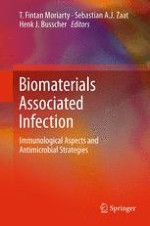2013 | OriginalPaper | Chapter
7. Dendritic Cell–Biomaterial Interactions: Implications for the Onset and Development of the Foreign Body Response
Authors : Antonio S. Sechi, Behnaz Shokouhi
Published in: Biomaterials Associated Infection
Publisher: Springer New York
Activate our intelligent search to find suitable subject content or patents.
Select sections of text to find matching patents with Artificial Intelligence. powered by
Select sections of text to find additional relevant content using AI-assisted search. powered by
